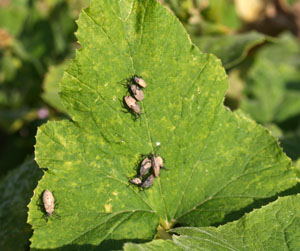
The squash bug, Anasa tristis, is common pest found on squash and pumpkins throughout the United States. It will also occasionally feed on other curcurbits as well (cucumbers, melons, and gourds). This shield-shaped insect sort of resembles a stink bug, but is a bit larger, more elongated and gray instead of green.
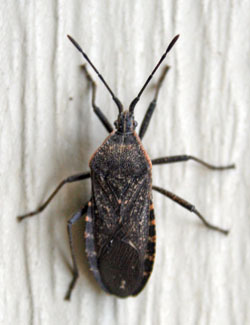
Adult squash bugs are about 5/8” long. They are gray to black with orange and brown stripes along the edges of the abdomen. They overwinter amid plant debris, under rocks, or in other protected places in the yard. They emerge over an extended period in late spring, and fly to squash plants when the plants begin to grow.
Females lay eggs on the undersides of squash leaves. The elliptical eggs vary in color from tan to orange to brick red. They are laid in small clusters of a dozen or more, often in characteristic triangular or V shapes in the angles formed by leaf veins. The eggs get darker in color just before hatching in a week to 10 days.
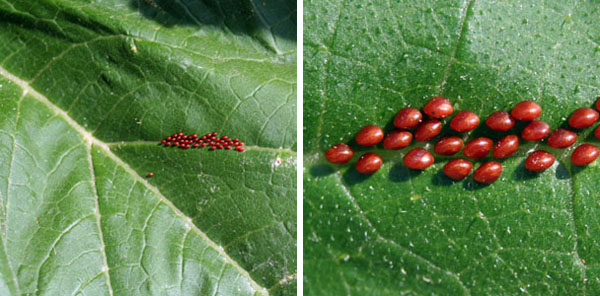
The small nymphs (juveniles) have red heads and legs, and greenish bodies. As the nymphs age the red color turns to black and the older ones look like they are covered with a grainy gray powder. They go through 5 instars (juvenile substages) for up to 6 weeks before becoming adults. The nymphs commonly form groups at the base of the plant or under the leaves but disperse quickly when disturbed. There is only one generation per year in Wisconsin, but because of the extended egg-laying period, adults and nymphs are present throughout the summer.
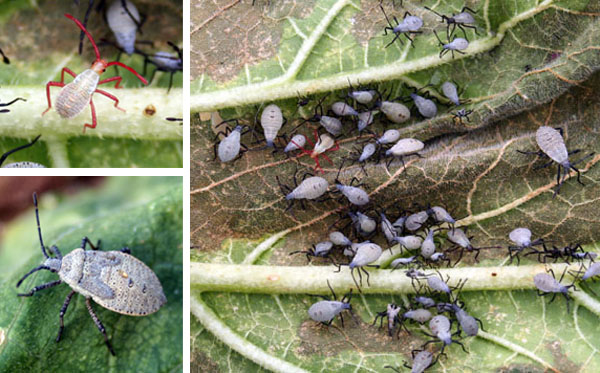
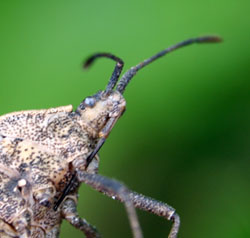
The squash bug is a true bug (order Hemiptera) with piercing sucking mouthparts. Both the adults and nymphs suck sap from plants, disrupting the flow of water and nutrients and injecting a toxic substance which causes vines to turn black and dry. They feed primarily on the foliage, but late in the season they may also feed on developing fruit. This causes wilting and blackening of the leaves, death of small fruits, and reduced quality of remaining fruit. High populations can literally drain plants, killing them.

There are several approaches to management of squash bug. Monitoring – checking plants for adult bugs and eggs – is important for effective control. Seedlings, new transplants, and flowering plants are the most critical growth stages to monitor, as these are the stages when the most damage can occur. Look on the underside of leaves for egg masses; destroying these and handpicking any adult bugs will often be sufficient to control this pest. Placing boards on the ground near the plants offers a convenient hiding place for the squash bugs. At night the squash bugs will aggregate under the boards and can then be destroyed each morning in small plantings.
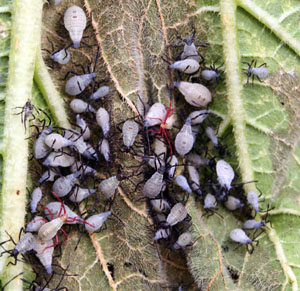
Sanitation is important for reducing overwintering populations of squash bugs. Remove the foliage after harvest to deprive any remaining nymphs of a food source to complete their development. Destroying or removing debris in the fall will limit overwintering sites for the adults.
Other cultural practices which lessen damage from this bug include maintaining a healthy plant (through proper fertilization and watering) to help tolerate feeding damage. Protect young seedlings with row covers. Certain squash varieties are resistant to squash bug. These include Butternut, Royal Acorn, and Sweet Cheese. Winter squash varieties, such as hubbards and marrows, suffer most severely.

There are a few natural enemies of the squash bug, including the tachinid fly Trichopoda pennipes and some egg parasitoids (Eumicrosoma spp.) which may provide some natural control. This tachinid fly lays its eggs externally on the squash bug adults, then the larvae hatch and move inside the body of the squash bug to complete their development. Don’t kill any squash bugs that you notice carrying little white eggs! The adult flies need nectar, so planting flowers such as dill, parsley, sweet clover, fennel, buckwheat, goldenrod, wild carrot, or amaranth in the nearby area may encourage these beneficial insects.
Chemical treatments for squash bug are somewhat limited for the home gardener. Convetional sprays (containing ingredients such as carbaryl, permethrin, or zeta-cypermethrin) are available at most garden centers. Options for organic control include insecticidal soap, horticultural oils, and pyrethrins. In commercial fields, the treatment threshold is an average of greater than one egg mass per plant. In the home garden, any egg masses and subsequent nymphs should be controlled. Treatments are most effective when applied just as the eggs are hatching as the small nymphs are more easily controlled. To maximize effectiveness of chemical controls, spray when nymphs are still small to medium in size; the adults are much less susceptible to sprays. Thorough coverage of the plants is important, as the nymphs are generally on the undersides of the leaves.
– Susan Mahr, University of Wisconsin – Madison
February, 2025





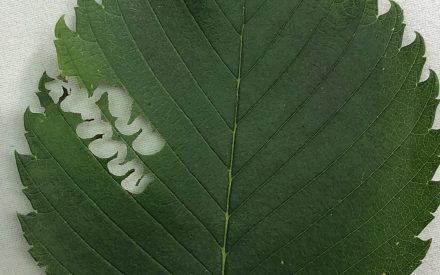 Elm Zigzag Sawfly
Elm Zigzag Sawfly ▶ Watch: How do Pesticides Affect Pollinators and Songbirds in Your Yard
▶ Watch: How do Pesticides Affect Pollinators and Songbirds in Your Yard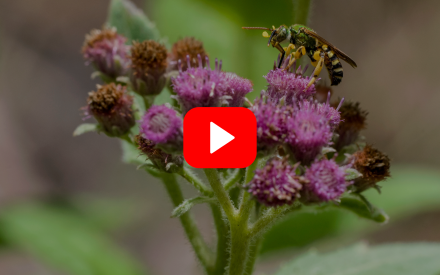 ▶ Watch: Pollinator Gardens: Plant Selection and Garden Care
▶ Watch: Pollinator Gardens: Plant Selection and Garden Care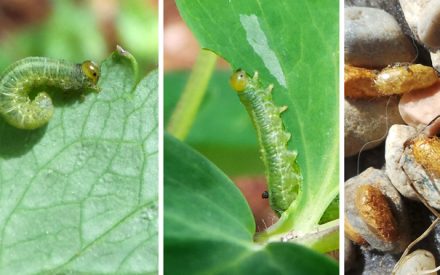 Strategies for Identifying and Managing Insect Pests
Strategies for Identifying and Managing Insect Pests


